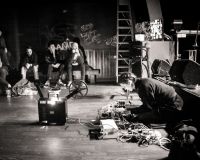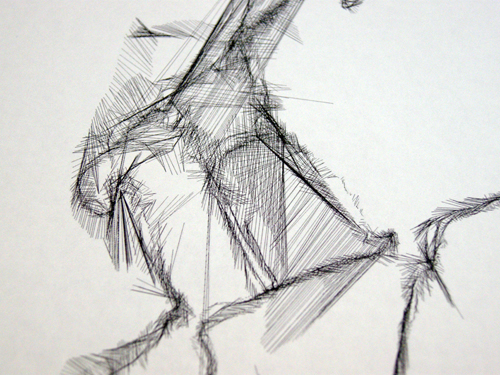Lunchtime talk write-up
Posted on Wed 22 Oct 2014
Colony Lunchtime Talk Write-up
On 19 September we were joined by Nikki Pugh, who has been in residence at the Studio over the past couple of months, filling the Studio with jiffy bags with beating hearts and laser cut, landscape-reactive ‘armadillo/slugs’. This is all in aid of the development of her project Colony, which…
Posted by

Jasmine Butt
Jasmine is a musician, synth builder and AV artist who is currently exploring modular synthesis.On 19 September we were joined by Nikki Pugh, who has been in residence at the Studio over the past couple of months, filling the Studio with jiffy bags with beating hearts and laser cut, landscape-reactive ‘armadillo/slugs’. This is all in aid of the development of her project Colony, which explores the tangibility of location data.
Nikki introduced herself an artist with a background in engineering. She is primarily interested in using projects to explore how we interact with the environments we find ourselves in. She is interested in the playfulness of pervasive gaming, but told us that she isn’t great at rule sets, structure and game narrative. In her latest work, she has been creating playful, unpredictable experiences that are defined by the environment in which they take place and the personalities of the people taking part.
In past projects, while she was becoming fascinated with maps, Nikki began dabbling with location technology – most notably GPS. She told us that she became captivated by the notion of using GPS as a tangible material, to build with, manipulate, or try to break. She started to create beautiful drawings using GPS data. The more built up an area is, the more faulty the GPS signal, and the more inaccurate the reading. Nikki carried two GPS units (one in each hand) around Digbeth, Birmingham, and made drawings by connecting the two conflicting coordinates plotted along her journey. She continued to create these drawings in Birmingham, and also took the idea to New York to develop her ‘Transverse Sections of Manhattan’ project.
After these experiments with GPS, an idea started to form about a possible project. Nikki imagined a group of around 6 people, each carrying a landscape-reactive creature around the city. The creatures would show signs of distress when they are taken into environments that they don’t like, and signs of contentment when they stay in environments they feel comfortable in. As the participants try to keep their creatures happy, their sense of empathy and responsibility creates invisible pulls, making them keep to certain environments, causing the group move in a certain way around the city.
One of the first iterations of the project saw Nikki making a number of objects, which she had programmed to buzz and vibrate in random patterns. She told people that they were landscape reactive, and was fascinated to see how responsive people were, and how quickly they came up with their own narratives around what the object was, and what it needed in order to stay happy.
Nikki embarked on a number of different residencies in different places and each time her creatures appeared in different forms, from huggable, light, subtly haptic creatures to huge burdensome objects. Each play-test proved a very different experience. Nikki then brought her project to the Studio with Arts Council funding, on a residency to experiment with haptic mechanisms and methods to convey the creatures’ emotional state. She made a laser cut heartbeat machine with a solenoid and an arduino, programming it to beat faster when GPS signals were distorted. Cushioned inside of a jiffy bag, or a little card-board box, the solenoid felt like the thumping heart of a small creature. It was bizarre to hold a jiffy bag and to feel so attune to its needs and responsible for its well-being.
Nikki recently spent a while cutting at Bower Ashton’s fabrication lab, with technician Sarah Barnes. In their latest iteration, the Colony creatures are large, lasercut “armadillo/slugs” with intricate street-map patterns cut out of each wooden section. Nikki toyed with the idea of covering it with a skin, but she decided she would rather people could see the inner workings. We were shown the different moods of one of the creatures, which had been switched to ‘purring mode’ for the majority of the talk. Nikki told us that the creature’s response to GPS data will be communicated through their tails, and their response to how close they are to the other creatures will be communicated through their heartbeats. The creatures will be programmed with their own personalities, some may be claustrophobic, some claustrophilic. There will be no way of knowing what kind of creature you are looking after until you are carrying it around and begin to empathise with it.
Nikki said that for her, the project only begins to work when humans come into play. The interesting bit is to see how people react to them, and change the way they move around the city. One recent play-tester wrote a brilliant blog about her experience, and described the creature that Nikki had placed in her care as “a cross between a Magic 8 Ball, a personality quiz, a pet, and an emperor”.
Nikki will continue to play with the idea that events and objects can break down barriers between people in public spaces, and cause them to consider their environment in a different way. We can’t wait to see where the project takes her next.
